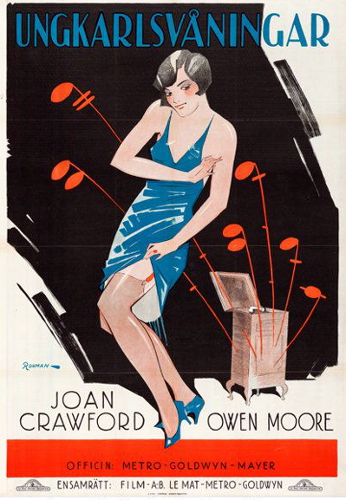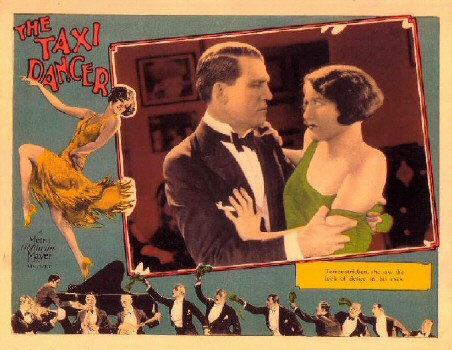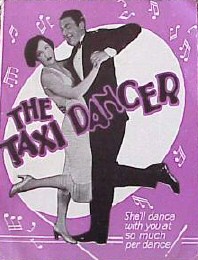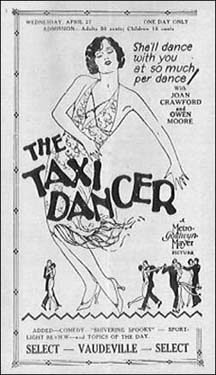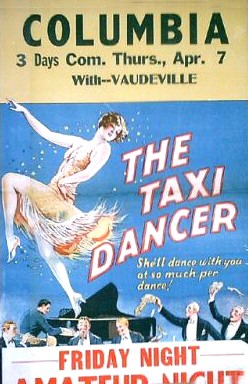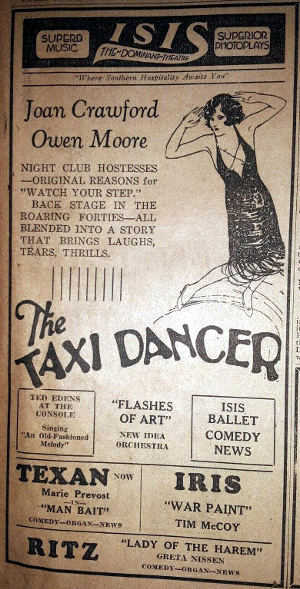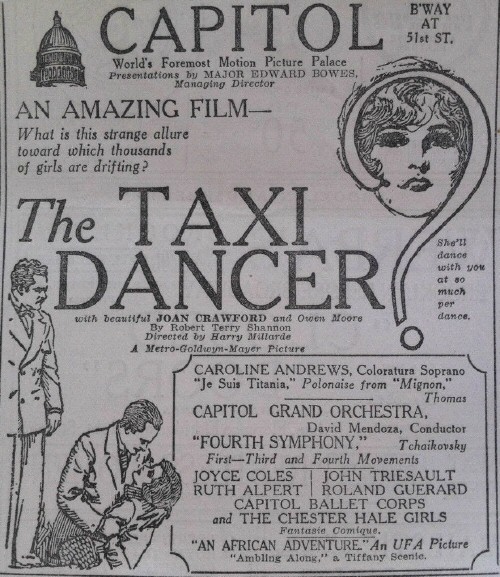James R. Quirk
in Photoplay
(1927):
Joan
Crawford...rides high over the inferior material. Here is a girl of singular
beauty and promise. And she certainly has IT. Just now she is very much in need
of good direction.
"Sid"
in Variety (1927):
Just
another Southern girl come north to be pursued by men, but not unentertainingly....Miss
Crawford could be termed as an in and outer in this picture. Every so often
comes a flash of power that may indicate this girl has something, while at other
times she's too coy and clinging... [O]ne of those pictures that will do well
in one town and flop in another. The flaps and their undergraduate or counter
monarchs will remain interested, while older men won't find it hard to gaze
on Miss Crawford and her array of nightgowns.
Mordaunt
Hall
in the New
York Times
(March 8, 1927):
If a story were written as it is invariably filmed it is highly
probable that readers would get fewer and fewer. The yarn of "The Taxi
Dancer" is one of those that seems to have lost its origin in being
transferred to the screen. There isn't a vestige of a character among
all the persons that flash on and off as the scenes are unfurled. Yet
there is a sort of lazy individual's diversion about this production.
You don't have to concentrate, and as things pass on you observe that a
man is killed and you are not in the least thrilled or sorry for him.
Then another man ends his life by jumping out of a window. And you may
say to yourself "That's that! The heroine is still alive, and so is
that uncouth individual who is in love with her."
This picture was directed by Harry Millarde, producer of "Over the
Hill." He distinguished himself by his work in that old Fox feature,
but in this new film his situations are artificial and his characters
are mere images based on movie life as it is reflected in its shadows.
The taxi dancer is not a person who dances on top of a taxicab nor
one who hops in and out of one of those vehicles, but a girl who is a
professional dancer, one who goes through the motions of a tango, waltz
or Charleston for a dime, half of which is contributed to the
establishment that furnishes her with the floor and a sort of uniform.
This particular taxi dancer is attractive, with the result that she
finds herself surrounded by admirers. These include a popular male
exhibition dancer, a millionaire and a gentleman who makes a living by
his wits—or, rather, through the witlessness of others.
There are some scenes in a rooming house, with contrasting types of
tenants. Lee Rogers (Owen Moore) spends his mornings singing, "You made
me what I am, &c," and his husky tones are annoying to Joslyn Poe,
the heroine of this lumbering yarn.
Some of Ralph Spence's subtitles are amusing. One of the lesser taxi
dancers is quoted as saying that she feels like a transport after
dancing with so many sailors. Another sets forth that a man is so
homely that he ought to have sued his parents.
So far as the actual acting goes it is neither very good nor very
bad. Joan Crawford could evidently do better under more inspiring
direction or in a well-knit story. She is appealing and endeavors to
submerge her own personality in her part so far as it is possible. Mr.
Moore, as Lee Rogers, is a trifle too rough even to be alluded to as a
rough diamond, which is not exactly his fault. Gertrude Astor does very
well with her part, but Mr. Spence makes her utter more slang than any
one girl could possibly know. Rockliffe Fellowes, who is usually able
to take care of himself before the camera, does not get much of a
chance in this production, as he is forced to die too soon.
Screenland
(May 1927)

biblio.com
(seller: ReadInk) (year unknown: 2000s):
Editor
Note: The below is a film-related excerpt from the "Taxi
Dancer" book review. Click biblio.com link above for full review
of the book.
...[F]irst
published as a syndicated newspaper serial beginning in May 1926. M-G-M
knew surefire movie material when they saw it, and by the beginning of
June it had already been synopsized by the studio's story department; a
full scenario was completed by September, and the resulting movie was
ready for release by the following March. It was the first film in which
a young Joan Crawford received top billing (it was early enough in her
career that at the time the story was acquired by the studio, she was
still being carried on the payroll under her original name, Lucille
LeSueur). It may not have been entirely coincidental that Crawford was
cast in a role in which dancing played such a central part: according to
many accounts of her career, frustration at her lack of progress
towards stardom under her early M-G-M contract led her to embark on her
own self-publicity campaign -- a major feature of which was entering
(and winning) numerous local dance competitions. The film may have been a
major career boost for Crawford, but for the studio it was just a
programmer: her co-stars were undistinguished, ditto the director (Harry
Millarde, then at the tail end of an unremarkable career), and the
movie was clearly not important enough for the issuance of an
accompanying "photoplay edition"...
|
 MGM
Silent. 64 minutes (7 reels).
MGM
Silent. 64 minutes (7 reels).



